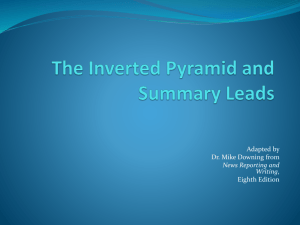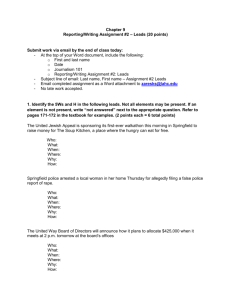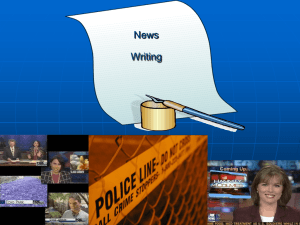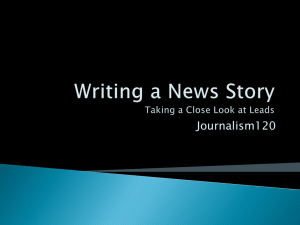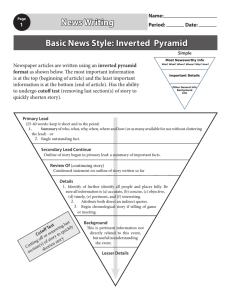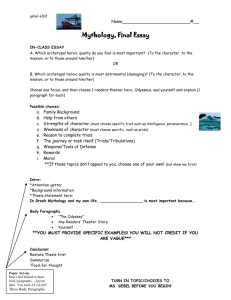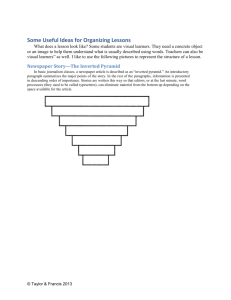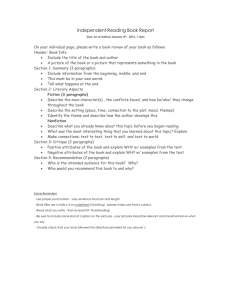Leads and Story Basics
advertisement
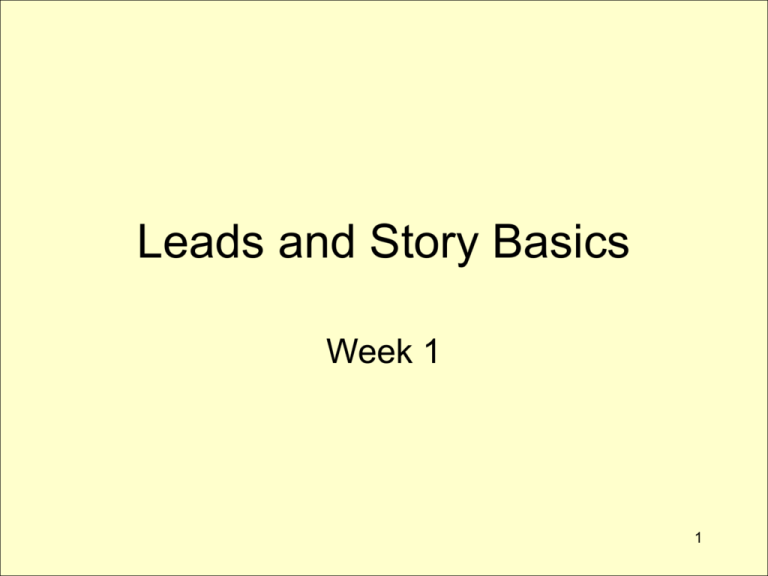
Leads and Story Basics Week 1 1 Topics for Today • • • • • • • What’s news Discuss broadcast news topics Basic story structure Leads Leads More leads Return to story structure 2 The inverted pyramid • Reports of its death have been greatly exaggerated. • Most important to least important – Newspaper readers spend 15 to 25 minutes per day reading the paper – Online subscribers spend even less 3 The inverted pyramid • Readers can find the key information first • Editors can trim less important information if necessary • Began in the Civil War (or before)? • Forces writers to rank the importance of the information (Key to good leads too) 4 The inverted pyramid • Lead comes first • Supporting paragraphs in descending order of importance – Multiple editions of a newspaper or newscast with story running different lengths • Negatives: It doesn’t encourage people to read the entire story 5 Leads • Clear, simple statement • First paragraph -- occasionally two paragraphs • Key news values – “So what?” or “Who cares?” 6 Leads - basic questions • • • • • • Who What When Where Why How 7 Lead basics • Ask these questions • A few other things as appropriate • Word limit? – 25 is good – Depends on the story – May be two sentences, if necessary • Remember, what do you want to know? 8 Leads • Telling someone a story when they’re trying to catch a bus • Just the facts . . . . • Avoid editorializing – Keep your opinions out • Double check spelling, address, key facts • Avoid too many numbers in the lead 9 A fire in Bryan caused $45,000 in damages to a two-bedroom home in the 2300 block of 28th Street. Fire officials said the fire was started by a lighted cigarette on a sofa. Firefighters arrived at the house at 3:30 a.m. to find it on fire. They had the blaze under control in five minutes. The homeowner, Kathy Mahoney, was awakened by the smoke and flames. She suffered minor burns on her hands and feet. 10 Alternate leads • Which item is most important? • What if: – Mahoney is the mayor of Bryan? – Mahoney is a convicted arsonist? • Have there been may fires caused by smoking this year? 11 Types of leads • “You” lead – Tells readers why they should care • Immediate-identification lead – Who is one of the most important facts • Delayed-identification leads – Who is one of the least important facts 12 Types of leads • Summary lead – Sums up what happened – Most common lead type • Multiple-element lead – Laundry list of topics – Use sparingly 13 Novelty Leads • Some stories are best written with an unusual lead 14 A Santa Ana woman was charged with attempted murder yesterday. She was being held in the Orange County jail after being unable to post $250,000 bond. Police said the woman, June Carter, 71, doused her husband, who was confined to a wheelchair and had cancer, with rubbing alcohol and set him on fire. Police said she was angry because he ate her chocolate Easter bunny. She called paramedics six hours after the attack on her husband. Paul Carter, 62, was taken to the University of California Irvine Burn center with third-degree burns, police said. 15 Story organization • A good lead makes the rest of the story easy to write • Following the lead, introduce any additional important information • Explain the “so what” if possible • Elaborate on the information in the lead 16 Story structure • Develop the ideas in the same order they are introduced • Generally, use one paragraph per idea • [Yes, you can have one-sentence paragraphs] 17 Multiple-element stories • A multi-element lead frequently means a multiple-element story • Board meetings, council meetings • Options – More than one story – A summary box (nice graphic element) • Multi-element story -- same format as regular story. 18
